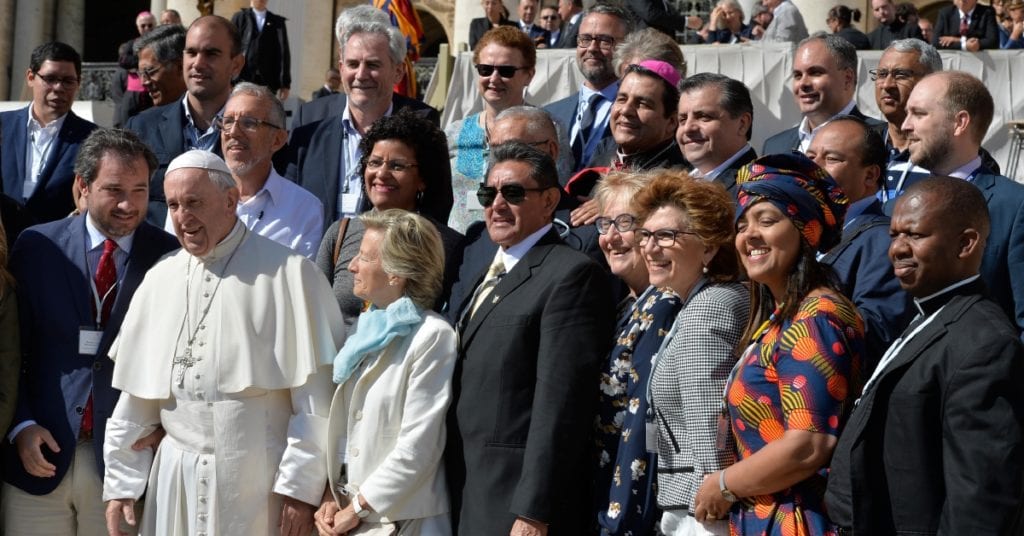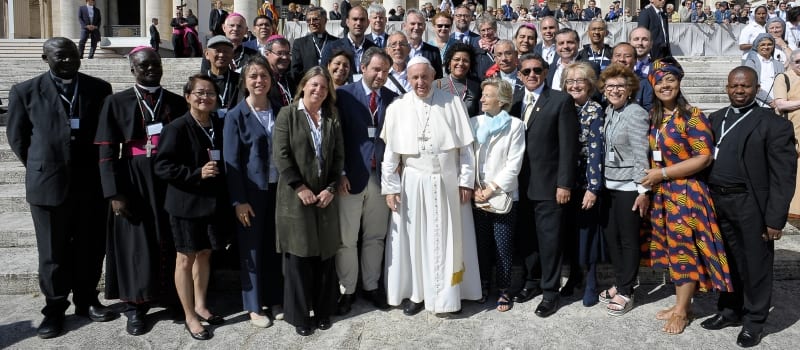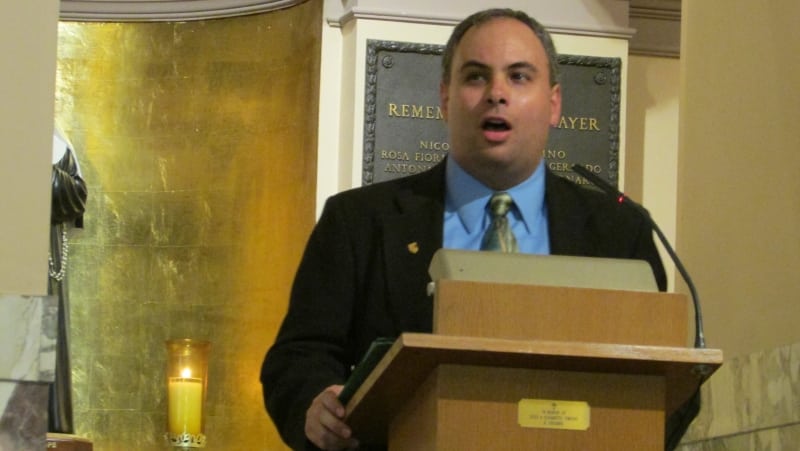Dr. Marc DelMonico (fourth row back, center right) and delegates from 15 episcopal conferences for the international meeting “Promotion & Formation of the Laity: Best Practices,” with Pope Francis, following the papal general audience of September 26, 2018. (Image credit: Servizio Fotografico Vaticano. Used with permission.)
As mentioned in a previous post, in late September I made my first-ever trip to Rome. In my capacity as Assistant Director of Certification for Ecclesial Ministry and Service at the USCCB, I was asked by executive leadership to co-present with a colleague from the Conference at a first-of-its-kind international meeting sponsored by the Vatican’s Dicastery on Laity, Family and Life. The purpose of the meeting was to highlight the initiatives for forming the laity to live their vocational and baptismal mission, in accordance with the diversity of cultures and particular needs of each country. The three day meeting was an intense and joyful exchange of ideas, information and fellowship which I will share more about in the coming weeks. I also wish to express by gratitude to Msgr. Jeffrey Burill, Associate General Secretary of the USCCB, along with others on the executive team, and my predecessor in the Office of Certification, Dr. Harry Dudley, for their efforts to secure a place for me in the delegation.
The defining moment of the three-day gathering for the 40 representatives from 15 Catholic episcopal conferences around the world was a unique experience of the General Audience of Pope Francis in St. Peter’s Square, followed by an unexpected reception and photo with the Pope himself! I wanted to share some reflections on this humbling and beautiful encounter with the Bishop of Rome – a man whose holiness frequently shines through in his thoughtful words, his humility and his receptivity to God’s grace, however it comes. Yet, even as I recognize his unshakable faith and gentleness, I am impressed by the resolve of this man who often faces unexpected and vocal resistance to his efforts to re-kindle faith in Catholics, enable structural reform of the institutional church, and speak with bold prophetic witness on the key social crises of our time.
Early on the morning of September 26, our delegation departed the beautiful grounds of Casa San Juan de Avila – the residence for students, pilgrims, and visitors to Rome on the grounds of the Spanish Episcopal College where the meeting was held, and where the delegates stayed during our time in Rome. With the morning rush hour, it was about a 25 minute ride to St. Peter’s. Travelling on the top level of the double-decker bus with colleagues from South Africa and I sitting in the front row, I snapped this beautiful image en route, which remains my favorite stylistic environmental photo of the entire trip.

The view from the double decker bus top level en route to St. Peter’s Basilica on September 26, 2018.
When we arrived, since we were guests of the Dicastery, we walked through the special entrance at the Piazza de Protomartiri Romani (Plaza of the Early Roman Martyrs – a reference to Sts. Peter and Paul who were both martyred in Rome in the late first century A.D.), south of the basillica. We walked by the Swiss Guard stand. It is this same entrance which the Pope would later use to enter the Piazza del San Pietro (St. Peter’s Plaza) some hours later in the Popemobile. We were escorted to the sections of seats reserved for special guests to the left of the covered stage where the Pope would sit. It was a beautiful clear day with temperatures near 70 degrees Fahrenheit – perfect weather. While we waited we got to know each other a little better (as it was our first morning together) and also had a wonderful vantage point to see pilgrims from all over the world filling the square. Another photo I took – below – shows the beauty of the day and the moving sight of pilgrims coming together as the world church to see the Pope. What I believe was either the Vatican band or a specially chosen band for the day kept us entertained, with numbers such as “Chariot (I Will Follow Him)” and “Shout,” which Catholics from the 1990s will remember were part of the movie Sister Act, in which Whoppi Goldberg portrays a lounge singer hiding undercover as a Carmelite religious sister who reinvigorates their choir with Motown classics turned liturgical music). They also played beautiful renditions of “Amazing Grace” and other sacred classics.

Some delegates from our group at the very bottom, the Vatican band over the edge of the wall and the thousands of pilgrims gathering in St. Peter’s Square on September 26, 2018.
At around 9:30 a.m., the Popemobile made its entrance and circled the crowd in the square several times as the Pope waved and occasionally interacted with some pilgrims. After he arrived on the dais, and following a hearty “Buongiorno!” to everyone, the prayer began followed by the general audience in which the Pope made general remarks (in Italian and, later, Spanish) about his recent activities and greeted the pilgrims of the various language groups through the aide of translators who present a summary of the Pope’s message in various languages. The Pope then greeted each language group and also named particular organizations represented in the piazza. Near the conclusion of his remarks, he included a special greeting for the Dicastery conference group. The video below begins at that point. (For the English summary of the Pope’s remarks go to timestamp 25:37.)
Immediately following the audience, the Pope went to greet special guests, and our group was escorted to the center of the stairs in front of the dais. While we waited, the Pope visited several groups of pilgrims, including several rows of pilgrims who were physically or developmentally challenged. He spent a lot of time with each one, along with their families and friends who were with them. While we awaited him, I was able to observe the time and care with which he greeted and spoke to each one. It was about 15 minutes to make it through the group. It was very moving to see the special care which the Pope had for these pilgrims.
Finally, he came to our group and greeted us, and we responded enthusiastically with applause. Our facilitator, Dr. Santiago Pérez de Camino, head of the Promotion and Formation of the Laity section of the Dicastery, introduced us to the Holy Father in his native Spanish as “laicos dedicados” (dedicated laity) who were here to meet and discuss best practices for forming the laity in the faith around the world. The Pope smiled at the mention of our purpose and said “Ah ‘laicos-laicos,’ non laicos clericalistas,” which means “Laity-laity, not clericalist laity.” This was heartily affirmed by our group as he shook hands of those who were closest to him, waved at each of us individually whom he couldn’t reach and paused for photos, capturing this beautiful moment forever.

The view of our group with the Holy Father from a different angle. I am in the last row, upper right. (Image credit: Servizio Fotografico Vaticano. Used with permission.)
What did the Pope mean when he spoke to us? He was affirming what Dr. Perez de Camino had said about the group: that we were genuine lay leaders in the church working to form the laity in the faith and highlighting an issue he has often spoke of – namely the avoidance of the sin of elitism in the church on the part of the clergy or the laity. This elitism is often known as clericalism – a form of institutional sin often seen among members of the clergy in which they presume their role in the church makes them higher or more important than the laity. Pope Francis has frequently spoken against clericalism and he views it as a significant spiritual and institutional malaise that must be dealt with in the church. Most recently, he identified it as a significant spiritual and institutional cause of the abuse crisis in the church and the abuse of power which has covered up institutional failures of accountability. His “Letter to the People of God,” was written in response to the August 2018 Pennsylvania grand jury report on sexual abuse of children by clergy over several decades, and the subsequent concern of further cover ups by bishops and other church leaders in the United States. In the letter, the Pope states “Clericalism, whether fostered by priests themselves or by lay persons, leads to an excision in the ecclesial body that supports and helps to perpetuate many of the evils that we are condemning today. To say “no” to abuse is to say an emphatic “no” to all forms of clericalism.”
It was thus not surprising that the Pope highlighted – even in passing – what has become one of the themes of his papacy, namely, to address formation of Catholics – and especially those in ministry – with an emphasis on power for service and a repudiation of a sense of power which seeks to dominate over others. It is an important theme drawn from the Second Vatican Council’s understanding of the church and, more fundamentally, from the biblical understanding of power for service, as it was practiced by Jesus.
The Pope’s affirmation of our work and his mention of the topic of clericalism proved fruitful in our subsequent meeting conversations as well, which I will speak about in a future post. His care for our work is clear, especially when one considers that it was he who elevated the Dicastery on the Laity to its current level within the Vatican (previously it had been a Pontifical Commission; making it a Dicastery greatly expands its scope and influence). The Holy Father has also focused much of his papacy on the promotion of missionary discipleship, with an emphasis on witnessing to the faith by living a life of commitment to the common good. By taking the time to both greet and speak to our group, Pope Francis affirmed the value of our meeting and its goal of identifying best practices in lay formation, including lay ministry, throughout the global church.



 Request Dr. DelMonico's professional services for a liturgical, ministerial or leadership consultation, or for an academic or public presentation.
Request Dr. DelMonico's professional services for a liturgical, ministerial or leadership consultation, or for an academic or public presentation.